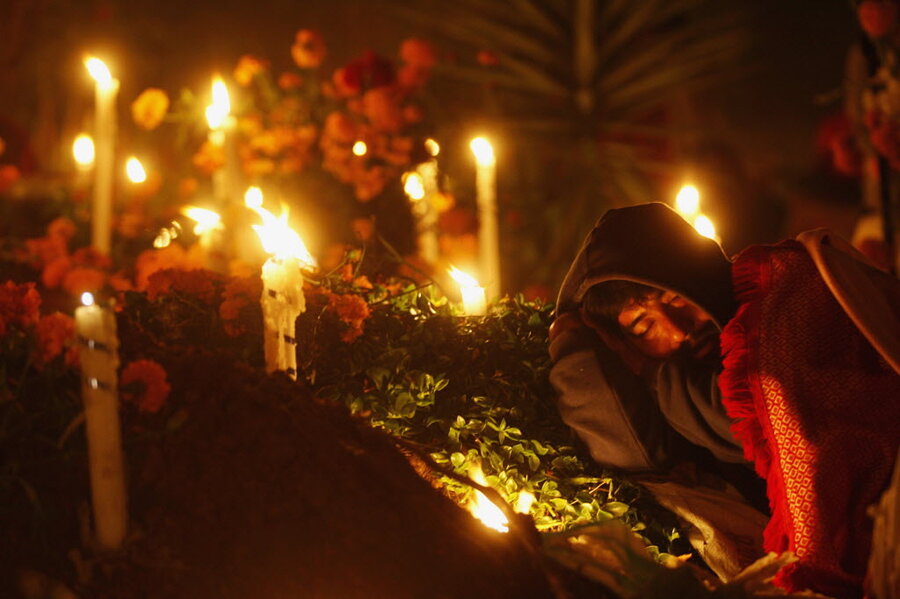As Day of the Dead looms, families of missing Mexican students hold out hope
| Mexico City
Orange and yellow marigolds and sugary breads are making an appearance across Mexico City this week as families prepare to celebrate the Nov. 2 Day of the Dead.
To commemorate deceased loved ones on this Catholic-inspired holiday, Mexicans build altars, visit graves, and leave offerings, such as a favorite food or drink.
But for weeks already, some of the parents of the 43 college students who disappeared a month ago in Guerrero state after an encounter with police have gathered around an “altar of hope” on their children's campus. It underscores their demand for answers in what has become a grim national scandal.
“What will come of them? We don’t know if he’s eating, if he’s injured, if they’re hitting him,” Clemente Rodriguez Moreno, whose 19-year-old son Christian disappeared with his classmates in September, told the Associated Press.
“I don’t sleep for the thinking,” said the father of another missing student, who asked not to be named. “I don’t feel like I’m living life.”
Two of four new suspects arrested in the case on Monday pointed authorities to a mass grave, located about 10 miles from the town of Iguala, where the students were last seen. It is the 11th clandestine burial site found since the students' Sept. 27 disappearance. DNA tests are underway; so far, other mass graves have either tested negative or the results are pending for student remains.
“We have the people who carried out the abduction of those individuals,” Attorney General Jesus Murillo Karam said Monday. The police now have more than 50 people in custody, including police officers, suspected gang members, and local government officials.
The government has vowed to find the missing students – and President Enrique Peña Nieto reiterated this promise on Monday while introducing the new governor of Guerrero state. “It’s imperative for us to know the whereabouts of the disappeared youth, and apply the law to those who are found responsible for these very unfortunate events,” President Peña Nieto said.
For some, the impending Day of the Dead celebrations highlight the larger tragedy Mexico is facing. An estimated 100,000 people have been killed in gang-related violence since 2007, Reuters reports. Families often don’t receive the government attention and press that Guerrero’s missing students have, instead taking on themselves the onus of investigating a relative's disappearance. The Christian Science Monitor reports:
Araceli Rodriguez has been thrown out of the Mexico City police station where her son once worked. She’s received threatening phone calls and menacing letters; she's battled reports calling her son a deserter. She’s traveled around the country seeking interviews with judges, local politicians, and convicted prisoners, looking for anyone able to shed new light on what happened to him.
“Of course I am afraid,” says Ms. Rodriguez, a soft-spoken woman with steel-blue eyes. She travels with a bodyguard now, but says it’s not the threats that keep her up at night. “I am more afraid of not knowing what happened to my son.”
Her inability to get the information she is pursuing so tenaciously has ramifications far beyond her own peace of mind….
Investors say Mexico’s lack of “rule of law,” meaning control and transparency in its courts and contracts, will be its biggest hurdle in attracting overseas investment.
On a very human level, this legal weakness is devastating for families like Rodriguez’s. It manifests itself in the bureaucratic obstacles and battles families face in trying to find out even the most basic information about disappeared relatives.
“People think twice or thrice before going out to the authorities, because they assume that there is collaboration between authorities and criminals, or they may feel [threatened] if they go and try to file a case,” says Juan Salgado, an associate professor of judicial studies at the National Autonomous University of Mexico. “Disappearances in Mexico are highly underreported as a crime.”
In a column for El País today, Jorge Hernández lambasts officials for not solving this crime in a society that is reeling from so much brutality:
It’s “an unpardonable shame that a month has gone by and the authorities don’t know – or if they do know, they aren’t saying – where all of Mexico’s missing are,” Mr. Hernández writes.
I’m talking about the 43 students, potential teachers, who disappeared in the middle of the night on Sept. 27, but also the thousands of other missing, dead, decapitated, chopped up, burned alive, buried alive, or dissolved through amnesia that populate the fog of many Novembers....






